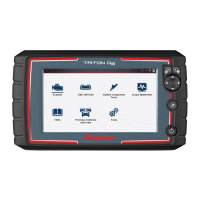Scope Multimeter Capturing Data
125
Figure 12-35
As there is a direct relationship between the length of time the data is captured
in, and the resultant level of detail you will have when reviewing it, review the
information in Saving Data Files on page 127 for tips on capturing and
reviewing data.
Using Zoom
For control icon descriptions, see Scope Multimeter Control Icons on page 104.
The zoom function is only available in Review Mode, and can be an invaluable tool
when searching for events of interest within captured data. Zoom effectively gives
you the ability to change the magnification level of the signal sweep during data
review.
As zoom, allows you to change the magnification level of the signal sweep, this
allows you to compress or expand multiple screens of data to quickly find glitches,
or signal losses.
Control icon function is normal when using zoom, with the following exception:
Forward 1 Frame / Back 1 Frame control icons - (press once) moves
multiple frames relative to the set magnification level (e.g. 2X setting, moves 2
frames; 16X setting, moves 16 frames).
When the Zoom icon is selected the display defaults to the "Max"
magnification level and a dropdown scroll menu will display (Figure 12-36).
The dropdown menu allows you to select the display magnification level from
a range of 1X to 512X (Max). The "Max" (maximum) option displays all data
captured on one screen.
It is important to remember that whatever sweep setting you used during data
capture is what the 1X zoom level will show.
The active zoom options (1X to 512X (Max)) that are selectable are dependent
on the amount of data stored in the buffer. Less data captured = less zoom
options. More data captured = more zoom options.
When zoom levels of 2X and higher are selected, a Zoom cursor (vertical dashed
line) (Figure 12-36) displays onscreen. The cursor is used to quickly mark and
navigate to points of interest or glitch in a captured waveform.
1— Back 1 Frame
Moves to the
previous frame in the data
2— Forward 1 Frame Moves to the
next frame in the data
3— Step Back Moves to the previous
point in the data
4— Step Forward Moves to the next
point in the data
5— Start (Capture) Resumes data
capture
6— Data Buffer Slider

